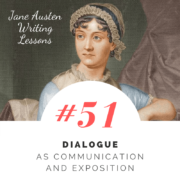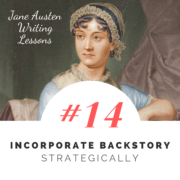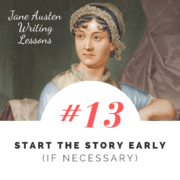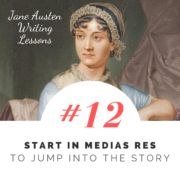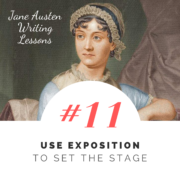Posts
#14: Incorporate Backstory Strategically
/0 Comments/in Jane Austen Writing Lessons/by Katherine Cowley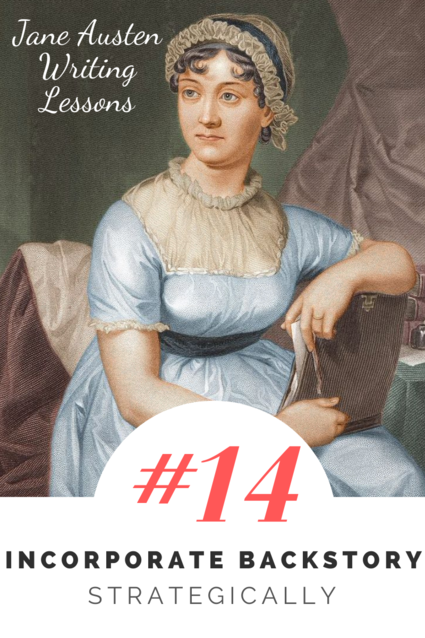
What is backstory?
Backstory is history and information about what happens before the story. Backstory is typically related to the characters, the situation, and the world in which they live.
Most backstory is never mentioned in a story—there are thousands of details and past events that inform the character and their community, thousands of excess details that your readers don’t want or need to know.
Yet there are plenty of details which the reader does need. The key is deciding how to share them.
One of the primary purposes of exposition is to provide backstory, yet too much backstory weighs down the exposition. Anytime you dive into past events, situations, details, and information, there’s a risk of creating an infodump.

An infodump is an excess of information that pulls us out of the narrative. Information is piled on the reader, who does not have direction, and who doesn’t feel any sense of connection to the information. When too much of this sort of information is given to the reader at once, none of the information has purpose or weight, and the reader often loses interest in the story.
Instead of creating a pile of information, consider the individual pieces, and how they could be incorporated. The soda can in this beach pile might not feel like garbage if we encounter it by itself, as we’re walking along the beach. We might see someone drinking it—it might bring up an interesting recollection of a past event or situation.
The author Jo Walton talks about the benefits of what she calls incluing, or “the process of scattering information seamlessly through the text, as opposed to stopping the story to impart the information.”
Backstory should be woven not just through the exposition of a story, but throughout the entire story.
Weaving in Backstory in Persuasion
In the exposition of Persuasion, Jane Austen establishes the Elliot family, the death of Lady Elliot, and the characters of the three daughters, including the oft overlooked Anne Elliot.
The heart of Persuasion is about Anne Elliot and her relationships, in particular her relationship with Captain Wentworth. Yet the crucial backstory about the relationship between them is not provided in the exposition of the novel, but is carefully woven throughout.
The Elliots have decided that in order to remain financially solvent, they must rent out their home, Kellynch Hall. In chapter 3, they discuss a possible tenant: Admiral Croft.
One line of dialogue gives us Anne’s viewpoint on the Navy:
“The navy, I think, who have done so much for us, have at least an equal claim with any other set of men, for all the comforts and all the privileges which any home can give.”
This is subtle backstory—it’s something she is saying in the moment, in response to her father’s prejudice. Yet it reveals her attitude towards those who serve in the Navy.
A few pages later, Anne is able to give specific details on what Admiral Croft is known for—that he fought in Trafalgar and has been stationed in the East Indies. Once again, this provides key backstory. As readers, we’ve learned that Anne knows much more about the Crofts than anyone in her family, yet we don’t yet know how she learned this information.
A few pages later, someone mentions that years back, someone had visited that had some connection to Admiral Croft, and after a pause, Anne volunteers a single detail.
“You mean Mr. Wentworth, I suppose,” said Anne.
Her hesitation, the lack of detail that she gives, all reveal things about Anne and her relationship with this family.
By the end of chapter 3 , Sir Walter Elliot decides that he will allow Admiral Croft to rent the estate. The chapter ends with this sentence.
No sooner had such an end been reached, than Anne, who had been a most attentive listener to the whole, left the room, to seek the comfort of cool air for her flushed cheeks; and as she walked along a favourite grove, said, with a gentle sigh, “a few months more, and he, perhaps, may be walking here.”
In this moment, we see Anne’s current emotions and thoughts, but backstory is also revealed: we are given a sense of love lost, and we see the agitation this creates for Anne.
Throughout this chapter, there have been plenty of opportunities where Jane Austen could have provided an infodump, even spots where it might be natural and not feel like an infodump. Yet by spreading the information, piece by piece, it allows the scene to build, it provokes our curiosity, it gives crucial insight into Anne’s character, and it prepares us for chapter four, when we are given a larger amount of backstory.
The first line of Chapter 4:
He was not Mr. Wentworth, the former curate of Monkford, however suspicious appearances may be, but a captain Frederick Wentworth, his brother.
The narrator then describes Captain Wentworth’s situation years before, and how he and Anne met and fell in love. It tells us of their short engagement, and how Sir Walter and Lady Russell had convinced Anne to break it off.
This is a lot of backstory, but by this point, we care about Anne and this backstory has meaning for us as readers.
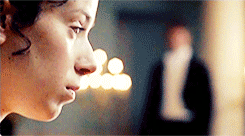
A gif from the 2007 film version of Persuasion: Anne and Captain Wentworth
Incorporating Information on a Need to Know Basis
Backstory is something that I often don’t get quite right in a first draft—it’s something I finesse during revision. But how do you do it? How do you weave it?
What Jane Austen often does is provide enough context ahead of time so the reader is oriented, and then adds information and backstory as the character interacts with present, current things.
For example, Uppercross is mentioned as the residence of Anne’s older sister, Mary. Mary invites Anne to go to Uppercross and she agrees. That’s our context. That’s what’s going to keep us oriented.
A few pages later, Anne goes to stay at Uppercross. Now, as she’s arriving at Uppercross, we receive a brief description of the village.
More details are given on a need-to-know basis, as they provide context, unravel character, forward the plot, and provide insights into the emotions of the characters:
Here Anne had often been staying. She knew the ways of Uppercross as well as those of Kellynch. The two families were so continually meetings, so much in the habit of running in and out of each other’s house at all hours, that it was rather a surprise to her to find Mary alone…
Here, we receive backstory on Mary’s strong connection to Uppercross. We see how familiar she is with it. And we experience this as she enters the cottage and finds her sister (surprisingly) alone.
Using Backstory to Build Moments of Emotional Impact
Backstory can also build to moments of emotional impact.
Captain Wentworth comes to Uppercross, and soon becomes friends with Anne’s host, which means that Wentworth and Anne must interact frequently.
They had no conversation together, no intercourse but what the commonest civility required. Once so much to each other! Now nothing! There had been a time, when of all the large party now filling the drawing-room at Uppercross, they would have found it most difficult to cease to speak to one another. With the exception, perhaps, of Admiral and Mrs. Croft, who seemed particularly attached and happy, (Anne could allow no other exception even among the married couples) there could have been no two hearts so open, no tastes so similar, no feelings so in unison, no countenances so beloved. Now they were as strangers; nay, worse than strangers, for the could never become acquainted. It was a perpetual estrangement.
This is a powerful, emotional moment of backstory, in which it is revealed how similar Anne and Wentworth were to each other, and how perfectly suited they had been for each other: “there could have been no two hearts so open.” Their similarity and how well suited they are for each other could have been revealed at many points of backstory prior to this, but instead, this bit of backstory is foreshadowed and saved for this moment, when it can have the greatest emotional impact because it is placed in contrast with Anne and Wentworth’s current relationship.
When you are using backstory for large emotional impact, limit the amount of backstory used. If we didn’t find out until now that Anne and Wentworth had been engaged, and then, at this moment, we found out they had been engaged and that they had been perfectly suited, this scene would be bogged down in the amount of impact, readers would be focusing on the new knowledge that they had a broken engagement, and their similarity would no longer have the space to have the same emotional impact.
When I’m editing and I see a scene where backstory is supposed to create emotional impact, I often realize that I’ve saved too much backstory for these scene, and I have to find pieces of backstory that I can weave in earlier so they aren’t distracting the reader from the true purpose and weight of the scene.
In Conclusion
Backstory should be included not only in the exposition, but throughout the entire novel. The incorporation of backstory is particularly suited to written fiction—it is much more difficult to include in film or theatre—and it provides insight into the character’s mind, perspective, experience, and emotions.

Exercise 1: Read the following paragraph.
Sandra stood at the edge of the dock, staring into the water. She could hear the other teenagers behind her, their laughter, their utter unconcern, as if this meant nothing. This meant nothing to them. They didn’t fear the water. She dipped her toe into the lake. She would be fine. She could do this. She closed her eyes, sucked in a breath of air and courage, and jumped.
Rewrite the paragraph, and as you do so, include 1 or 2 pieces of backstory.
This backstory could be about why Sandra fears water, what happened the last time she was in the water, or what happened to someone she knows, or it could be about the troubled history of this lake, a memory from this particular spot, etc. The type of information you choose to include will impact the emotion and direction of the paragraph.
Exercise 2: Take a novel that you have read at least once before. Skip the exposition, and now skim at least two or three chapters, looking for moments of backstory. Use post-it notes to mark these moments of backstory. Now analyze the author’s use of backstory:
- When is backstory incorporated?
- How is backstory incorporated?
- Are there moments where backstory is used to create emotional impact?
Exercise 3:
Take a story you have written and choose a key emotional moment that doesn’t include any backstory. Revise the scene to incorporate an element of backstory—small or large—in a way that increases the emotional impact of the moment.
#13: Start the Story Early (If Necessary)
/0 Comments/in Jane Austen Writing Lessons/by Katherine Cowley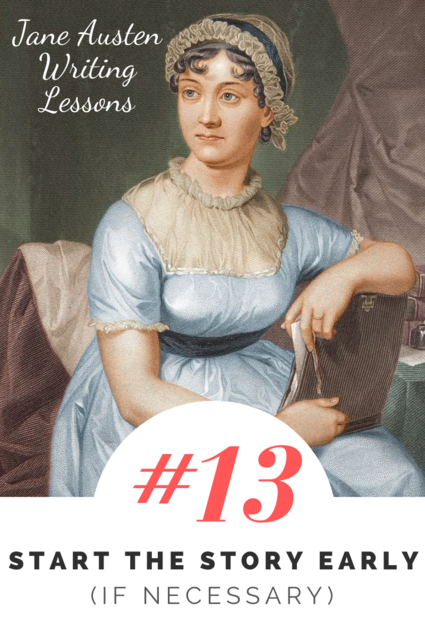
Most stories start not long before the inciting incident, providing a brief description, moment, scene, or a few chapters which encapsulate the period BEFORE—before everything changes for the characters. Emma and Persuasion provide good examples of this.
Other stories, like Pride and Prejudice, start after the inciting incident—in medias res.
Yet other stories take a very different approach to exposition and start long before the inciting incident disrupts the story (note that starting long before the inciting incident does not necessarily mean that the telling of the exposition needs to be long—expositions that start early can still be brief). Jane Austen uses this technique in two of her novels: Northanger Abbey begins at Catherine Morland’s birth, and Mansfield Park begins years before Fanny Price is born.
These two novels start the exposition early for two different purposes:
- Northanger Abbey: To show the main character’s life trajectory, and to contrast the inciting incident (and what comes as a result) against the character’s entire life.
- Manfield Park: To demonstrate a prior formative moment which caused a drastic shift in the main character’s life, and created a new normal, which is then disrupted by the inciting incident.

Life Trajectory in Northanger Abbey
Northanger Abbey demonstrates the main character’s life trajectory prior to the inciting incident. The novel begins with the line:
No one who had ever seen Catherine Morland in her infancy, would have supposed her born to be an heroine.
After this establishment of theme (and the delightful, rather satirical approach of the entire novel), we learn of Fanny’s birth:
Her mother…had three sons before Catherine was born; and instead of dying in bringing the latter to the world, as anybody might expect, she still lived on—lived to have six children more…
We follow Catherine Morland’s childhood, learning that she prefers cricket to dolls, seeing her disinterest in learning and watching her quit music after only a year or instruction. The narrator jumps from Catherine at age ten to age fifteen, and we see her continued development:
To look almost pretty is an acquisition of higher delight to a girl who has been looking plain the first fifteen years o her life, than a beauty from her cradle can ever receive.
Catherine reaches seventeen, with nothing to interrupt the path that she is on, a point that the narrator draws attention to:
She had reached the age of seventeen, without having seen one amiable youth who could call forth her sensibility; without having inspired one real passion, and without having excited even any admiration but what was very moderate and very transient. This was strange indeed!
All this in the first chapter. By creating a life trajectory, it establishes a shared set of reference points with the reader, reference points that help us understand the main character and who she is prior to the inciting incident. These references are essential, because without them, we would be unable to understand Catherine’s choices throughout the novel—her life trajectory informs her naivety, her desire to be liked, her fascination with new people and places, and how she constantly turns to books as an escape.
The last paragraph of the first chapter establishes the inciting incident, which is placed in direct contrast with the main character’s life to this point:
[Mrs. Allen], a good-humoured woman, fond of Miss Morland, and probably aware that if adventures will not befall a young lady in her own village, she must seek them abroad, invited her to go with them.
The other benefit of this approach to exposition is that it allows the narrator to avoid infodumps later—it would be difficult to include all of these details as backstory later in the story without unnaturally piling them on.
The elements included in Northanger Abbey are referred to again and again throughout the story, both directly and indirectly. By journeying with Catherine from her birth to age 17, we are prepared for the much bigger journey she will take throughout the novel.

Prior Formative Moment/Shift in Mansfield Park
While the exposition of Mansfield Park covers a lot of ground, the main purpose is for us to experience a formative moment, a huge shift, in Fanny Price’s early life.
Manfield Park starts before Fanny’s birth, and focuses on the weddings of the prior generation. Three sisters become, respectively, Lady Bertram, Mrs. Norris, and Mrs. Price. Mrs. Price is the one whose marriage has disappointed her family by being beneath her station. Mrs. Price loses contact with her family, and only reestablishes it when expecting her ninth child. At this point, her oldest daughter, Fanny, is nine years old, and is about to experience a cosmic shift, caused by her aunts, Lady Bertram and Mrs. Norris, and her uncle, Lady Bertram’s husband, Sir Thomas.
Mrs. Norris was often observing to the others, that she could not get her poor sister and her family out of her head, and that much as they had all done for her, she seemed to be wanting to do more: and at length she could not but own it to be her wish, that poor Mrs. Price should be relieved from the charge and expense of one child entirely out of her great number. “What if they were among them to undertake the care of her eldest daughter, a girl now nine years old, of an age to require more attention than her poor mother could possibly give? The trouble and expense of it to them, would be nothing compared with the benevolence of the action.” Lady Bertram agreed with her instantly. “I think we cannot do better,” said she, “let us send for the child.”
Sir Thomas is initially resistant the idea but is won over by his sister-in-law and wife. As the scene continues, we come to understand the character of these three adults, and without having met Fanny, we know intuitively that this is not going to be a warm, welcoming place for her.
We meet Fanny in Chapter 2, as she begins her “long journey.” We are with her throughout this epic change; we feel her discomfort as she is introduced to the family, and we see into her mind and character:
Her consciousness of misery was therefore increased by the idea of its being a wicked thing for her not to be happy.
Fanny struggles on and on. Through her eyes, we see how inferior she feels compared to her cousins, and how unrefined. In this exposition, we also come to know, in more depth, one of the other key characters of the novel, Edmund Bertram.
A week had passed in this way, and no suspicion of it conveyed by her quiet passive manner, when she was found one morning by her cousin Edmund, the youngest of the sons, sitting crying on the attic stairs.
“My dear little cousin,” said he, with all the gentleness of an excellent nature, “what can be the matter?”
A touching scene follows in which Edmund helps Fanny share her thoughts. He comes to learn about her family and her relationships with her siblings. He also helps her write and send a letter, promising she will not have to pay for it. This first real moment between Edmund and Fanny sets up their entire relationship, which is such a huge part of the novel, and it is better experienced in scene rather than through summary or flashback.
Thus, in chapter 2, we experience this great upheaval in Fanny’s life, and we see her adjust to the new normal, the new status quo.
If there has been a formative moment, a grand shift in a character’s life, there is power in allowing the reader to experience it with the main character. If this sort of shift merits being part of the exposition, it is typically large enough that in a different story it could be the inciting incident. Yet if used as exposition, it establishes a new normal, which is then disrupted by the inciting incident.
If Fanny’s removal to Mansfield Park was the inciting incident, the novel would be about ten-year-old Fanny and the internal and external journey she takes as she adjusts to her new life. Instead, this adjustment is covered in a single chapter, paving the way for the actual inciting incident, which is Mr. Norris’ death and the arrival of a new set of rather disruptive characters: Mr. and Mrs. Grant, Mr. Crawford, and Miss Crawford. These new characters disrupt not just Fanny’s life, but the lives of the entire family. But for Fanny, this disruption, this inciting incident, feels deeper, because this is not the first huge disruption she has experienced.
In Conclusion
In Northanger Abbey and Mansfield Park, Jane Austen uses two of the major approaches for starting a story early: providing a life trajectory, and depicting a prior formative shift. Yet starting the story early is not the only good approach to exposition, nor should it be the default. In Persuasion there are several formative shifts for Anne prior to the start of the novel—her mother’s death and her short-lived engagement. Yet Anne’s experience of these moments is revealed effectively through backstory, and in fact, their placement later in the story serves to reveal Anne’s character and her regrets at key moments.
If you want to start the story early, there needs to be a good reason for us to experience these scenes with the character. This experience should be enlightening to us, and, like in Northanger Abbey and Mansfield Park, there needs to be a reason that they must be experienced at the beginning. We should start our stories early if it helps us understand the logic of everything else.

Exercise 1: Find another story—a book or a film—that starts early. Now analyze it. Is it painting a character trajectory? Is it showing a prior disruptive moment? Or is it doing something else entirely?
Exercise 2: Take one of your characters (or an idea you have for a character) and write a 500-word life sketch, that begins either before or at their birth. Once you’re finished, analyze the results:
- What new things did you learn about your character?
- What were the biggest, most defining moments in your character’s early life? What shaped them into who they are as they enter the story?
- Are there elements of your character’s early that should be woven into the story as backstory? Or is this a case where it would be useful to experience the character’s early life as part of the exposition?
Even if none of the life sketch is incorporated into the story, writing it is a useful practice that can help you understand your character, their personality, and their choices.
Exercise 3: Take a fairy tale or classic story that does not give many specific details about a character’s younger years (for example, Elizabeth Bennet in Pride and Prejudice). Brainstorm specific events and incidents that could have occurred before the start of the story, and would be in keeping with their character, the story world, and what we do know.
#12: Start In Medias Res to Jump Into the Story
/0 Comments/in Jane Austen Writing Lessons/by Katherine Cowley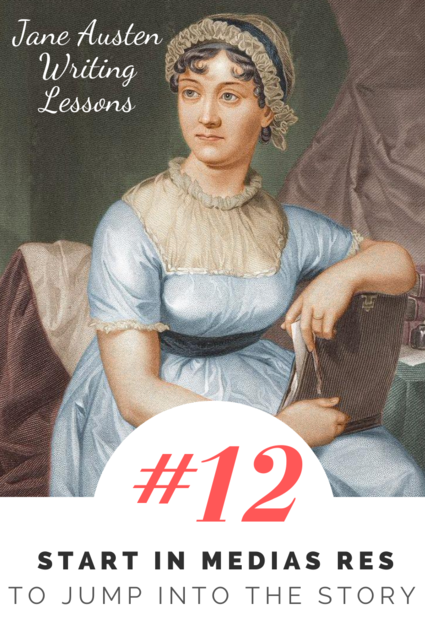
I have an unpublished novel that I wrote and revised years ago. It’s a pretty good story, but the beginning never worked. I tried starting it dozens of ways, establishing the exposition this way and that, and ultimately, I set the story aside. Now, as I look back on it, I realize that I was starting the story way too early. If I were to revise it again, I would start it much later, in medias res.
In medias res means, literally, “in the middle of things.” It’s a term originally used by Horace over 2000 years ago in his work Ars Poetica (Poetic Arts).
Basic plot structure demands that a story needs a Beginning, a Middle, and an End. But sometimes, a story does not actually need a Beginning. Or at the very least, it doesn’t need to start at the beginning.
Unlike Jane Austen’s other novels, which begin with paragraphs or chapters of exposition, establishing the characters and the world, in Pride and Prejudice, we begin in medias res. The inciting incident is that Mr. Bingley has joined the community—and this inciting incident occurs before the first page of the book. As we’ve previously discussed, inciting incidents disrupt the world of the characters, shaking them out of stasis and starting them on their journey.
In many cases, we need exposition before we can understand or appreciate how the world has been changed and its characters have been incited into action. Yet there are benefits to jumping straight into the heart of the story.
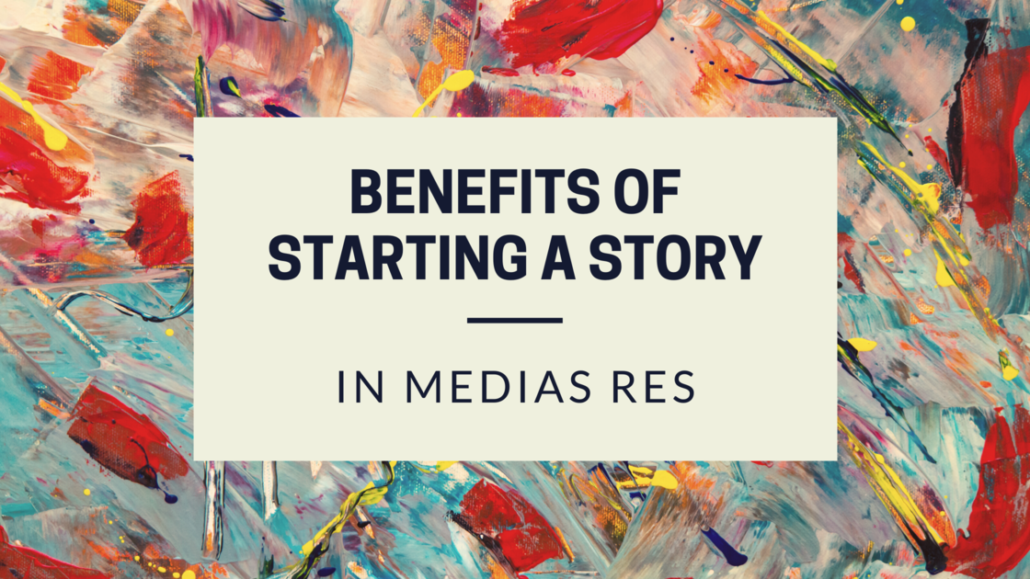
Benefits of starting a story in medias res:
-It immediately focuses the reader on the main stakes
-There is inherent excitement, energy, and movement in what comes after the inciting incident
-It avoids what could be (in certain stories) slow or unnecessary exposition
-It can create suspense to learn not just what will happen next, but also, what happened before
Chapter 1 of Pride and Prejudice
The first two paragraphs (beginning with the famed “It is a truth universally acknowledged”) are thematic, and provide commentary on society and the characters without providing true exposition. Then, starting with the third paragraph we read:
“My dear Mr. Bennet,” said his lady to him one day, “have you heard that Netherfield Park is let at last?”
Mr. Bennet replied that he had not.
“But it is,” returned she; “for Mrs. Long has just been here, and she told me all about it.”
Mr. Bennet made no answer.
“Do you want to know who has taken it?” cried his wife impatiently.
“You want to tell me, and I have no objection to hearing it.”
That was invitation enough.
We are brought immediately into the action of the novel, as Mrs. Bennet attempts to use all of her powers of persuasion to convince Mr. Bennet to call on Mr. Bingley so their daughters can be introduced to this newly-arrived, eligible bachelor.
Without need for straightforward exposition, we are introduced to things that would commonly be established in a more traditional exposition: the characters’ attributes and the importance to Mrs. Bennet of marrying her daughters.
“What is his name?”
“Bingley.”
“Is he married or single?”
“Oh! Single, my dear, to be sure! A single man of large fortune; four or five thousand a year. What a fine thing for our girls!”
“How so? how can it affect them?”
“My dear Mr. Bennet,” replied his wife, “how can you be so tiresome! You must know that I am thinking of his marrying one of them.”
“Is that his design in settling here?”
“Design! Nonsense, how can you talk so! But it is very likely that he may fall in love with one of them, and therefore you must visit him as soon as he comes.”
If dialogue is used, as it is in this case, to give hints of exposition, it must seem natural that the characters would really say these things. The effectiveness of including these details derives from the fact that Mr. Bennet is attempting to annoy his wife and feign ignorance of her matrimonial plans.
Interestingly, we don’t actually see the main character—Elizabeth—in a scene until Chapter 2. In Persuasion, each of the three sisters is given a thorough introduction by the narrator, and then we meet them and see them in action. In Pride and Prejudice, we are not given a through exposition to establish the characters; we must learn of them on the way. In the first chapter, Mr. and Mrs. Bennet only specifically reference three of their daughters, and do so only briefly:
“I will send a few lines…to assure him of my hearty consent to his marrying which ever he chuses of the girls; though I must throw in a good word for my little Lizzy.”
“I desire you will do no such thing. Lizzy is not a bit better than the others; and I am sure she is not half so handsome as Jane, nor half so good humoured as Lydia. But you are always giving her the preference.”
“They have none of them much to recommend them,” replied he; “they are all silly and ignorant like other girls; but Lizzy has something more of quickness than her sisters.”
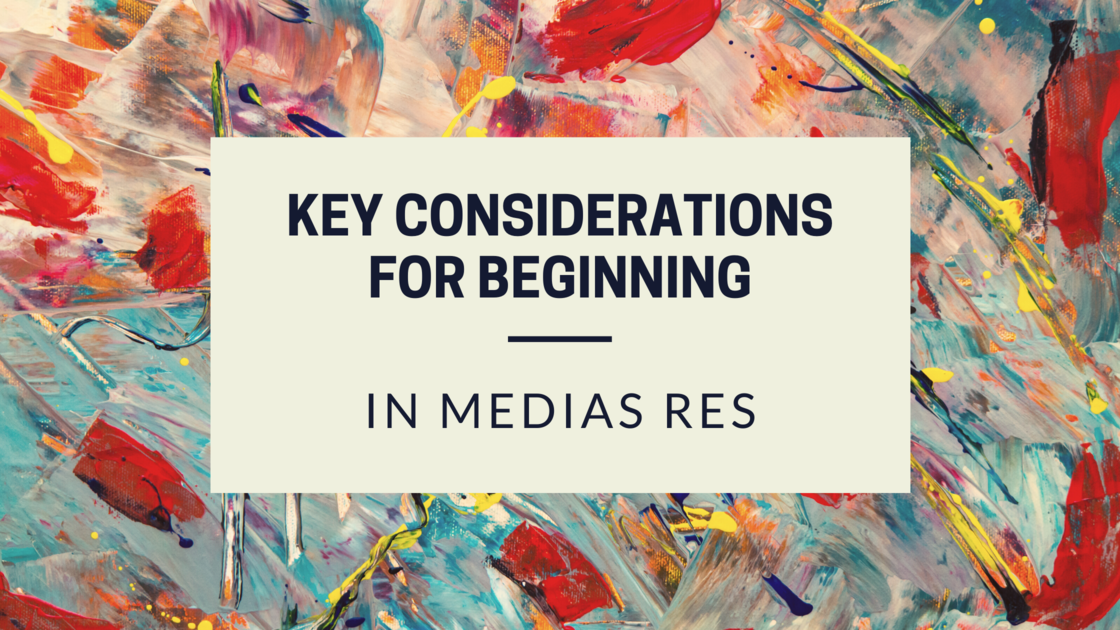
A Few Key Considerations for Beginning In Medias Res
If you’re going to start in medias res, the opening scene must be understandable without exposition or explanation.
If you’re starting in medias res, it still must be very clear how the inciting incident has changed the story world and set the characters on their journey.
And, perhaps most importantly, if you’re starting in medias res, you must avoid the temptation to infodump—to dump information, backstory, and exposition on the reader in order to provide them with what you think they surely need to know before experiencing your story.
Now, I’m going to rewrite a short portion of Chapter 1 of Pride and Prejudice, and I’m going to intentionally ruin it by adding too much backstory and exposition:
“My dear Mr. Bennet,” said his wife, Mrs. Bennet, “have you heard that Netherfield Park is let at last?” Mrs. Bennet was a woman in her early forties, who often forced conversation on her husband.
Mr. Bennet replied that he had not, though this was not strictly true.
“But it is,” returned she; “for Mrs. Long has just been here, and she told me all about it.”
Mr. Bennet made no answer. The surest way to annoy his wife—which was a source of endless entertainment for him—was to say nothing.
“Do not you want to know who has taken it?” cried his wife impatiently. He had to listen to her, he had to act, for they had five daughters, and if Mr. Bennet died, they would lose the house and be thrown out on the streets. Maybe, the new tenant, Mr. Bingley, would marry one of their daughters and save them from this fate. Jane would serve well, as she was the oldest and most handsome, though the other four daughters would also be an acceptable solution, should Mr. Bingley be drawn instead to Elizabeth, Mary, Kitty, or Lydia.
Now that was a truly intolerable passage. If you start your story in medias res, don’t do that. Do it like Jane Austen did it.

Exercise 1:
Take a novel that you’ve never read, and start reading it several chapters in. Or, take a movie you’ve never seen and start at least 15 or 20 minutes in.
As you read or watch, how do you figure out what’s going on? How do you orient yourself? How did you learn about the characters, and what can you conclude about what happened previously?
Write about your experience doing this in the comments, and what this teaches us about starting in medias res.
Exercise 2:
Some stories that begin in medias res are nonlinear—they do not take a straightforward path through time, or in other words, they do use a sequential structure.
The most common nonlinear structure is to start in the middle of the story for the prologue or an opening chapter, then to leap back in time and tell the story from start to finish.
There are many stories that use more complicated nonlinear structures, moving us back and forth from what point to another. This requires a very close attention to craft, clues embedded in the narrative that keep the reader oriented within time (unless part of the point is to disorient them), and a purposeful approach to juxtaposing one scene with another.
Choose a story that you like to tell people about something that happened in your life—an embarrassing moment, how you met a significant other, etc. Now write down the story using a nonlinear—yet still cohesive—structure.
Exercise 3:
Take a short story or a novel that you’ve written that begins with exposition. Take a few minutes and experiment with reorganizing the story so it starts in the middle of things. How late could you start the story? What details can you weave in later?
#11: Use Exposition to Set the Stage
/0 Comments/in Jane Austen Writing Lessons/by Katherine Cowley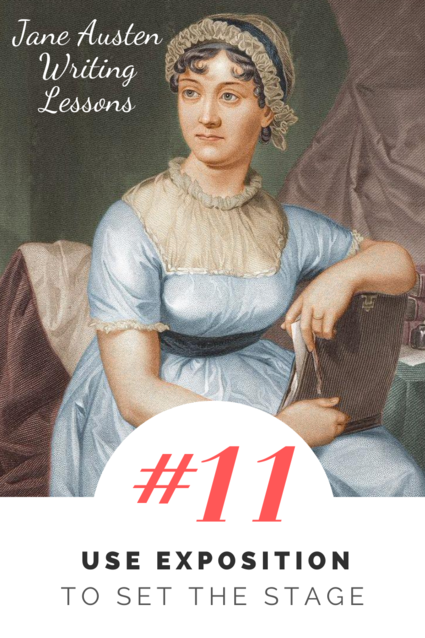
Soniah Kamal’s novel Unmarriageable, an incredible retelling of Pride and Prejudice in modern-day Pakistan, opens with Alysba Binat (our Elizabeth counterpart) teaching Pride and Prejudice at an English-speaking high school in Pakistan. In the beginning scene, she has her students—all female—write their own first lines inspired by the first line of Pride and Prejudice, their own “truths universally acknowledged.” As Alys leads the discussion, she brings up double-standards for men and women, explains that women’s independence is not a Western idea and has roots in their own culture, and raises the possibility that a woman’s sole purpose is not to marry and have children.
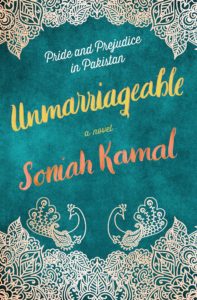
One of the ninth graders arrives late to class, a diamond engagement ring on her hand, and eventually the students turn the questions to Alys—why are you not married?
“Unfortunately, I don’t think any man I’ve met is my equal, and neither, I fear, is any man likely to think I’m his. So, no marriage for me.”
This scene sets up the core conflict of the novel—will Alys find her equal and eventually marry? It also sets up Alys’ personality, her quest to educate the young women of her community, and the cultural context in which she lives. In the first two chapters we also learn of her conflicts with the principal, information about her four sisters, how the family has lost their fortune and gotten into the financial straits that require the two oldest sisters to work, and we get a sense of the city and where it’s wealth and poverty are located. All this is so the stage is set, so that when the inciting incident disrupts Alys’ life and moves her on her journey (in the form of an invitation to a huge wedding where they will meet Bingla and Darsee), we as an audience are ready for it.
This is exposition, the setting of the stage for the story in order to provide important background information to the reader about the characters, their history, and their world.
As discussed in the lesson on plot structure and external journeys, the exposition shows the world in stasis, and it requires the inciting incident to launch the external journey of the plot and the internal journey of character transformation.
According to Oxford Languages, the word exposition comes from the Latin verb exponere, which means to “expose, publish, [and] explain.”
exponere = to expose, to publish, to explain
Good exposition should:
Give us an understanding of the main character, and possibly of other characters
Present key details from the character’s past and history
Provide enough worldbuilding (details about the world in which the character lives, and how it functions) to orient the reader
Focus on details that will demonstrate the disruptiveness of the inciting incident
Subtly raise themes and issues which will explored throughout the story
The first four paragraphs of Jane Austen’s novel Emma provide the exposition for the story. We begin with the opening line:
Emma Woodhouse, handsome, clever, and rich, with a comfortable and happy disposition, seemed to unite some of the best blessings of existence; and had lived nearly twenty-one years in the world with very little to distress or vex her.
This quickly paints an image of Emma’s character, her high place in society, and her general satisfaction with life.
In the second paragraph we learn the following, which brings up key details from Emma’s past and sets up the world and her place in it:
- Emma is the second daughter
- Her sister is married and gone
- She is mistress of the house (or basically, the female manager of it)
- Her father is “affectionate” and “indulgent”
- Her mother died when she was very young
- Her governess acted as a replacement mother figure in her life
That’s a lot for one two-sentence paragraph: Jane Austen manages to swiftly set the stage.
The third paragraph goes into more details on the governess, Miss Taylor, because these details will demonstrate the disruptiveness of the inciting incident:
- Miss Taylor has been with the family for 16 years
- She is more of a friend or sister figure than a governess
- She does not restrain or direct Emma (and has not for quite some time)
- “They had been living together as friend and friend very mutually attached, and Emma doing just what she liked; highly esteeming Miss Taylor’s judgment, but directed chiefly by her own.”
The fourth paragraph raises the themes and issues which will be explored throughout the story. In this case, it’s a look at the flaws in Emma’s character, and how these flaws will drive the narrative:
The real evils indeed of Emma’s situation were the power of having rather too much her own way, and a disposition to think a little too well of herself: these were the disadvantages which threatened alloy to her many enjoyments. The danger, however, was at present so unperceived, that they did not by any means rank as misfortunes with her.
By the time we reach the fifth paragraph, all the essential details have been explained, and we are prepared for the inciting incident: Miss Taylor’s marriage.
We learn plenty of other details of backstory as the novel progresses—details about the past and about Emma’s relationships with others in her community—but these are not included in the initial exposition, because they are not essential for setting the stage.
Sometimes exposition—this setting of the stage for the reader—takes several chapters, as in the example of Unmarriageable. Other times, it takes a few paragraphs, such as in Emma. The next lesson will discuss stories that start in medias res, at the moment of the inciting incident, or sometimes even after the inciting incident, and address how exposition can be incorporated in small amounts as the story progresses.
Regardless of the manner in which the exposition is presented, it sets the stage for the story and orients the reader.

Exercise 1: In the beginning of Emma, Jane Austen uses an omniscient storyteller point of view. She sets forth the character, the world, and the situation through the perspective of a storyteller introducing her cast. The narrator is insightful and interesting, and is unafraid to comment on her characters and their attributes.
Brainstorm a new character by choosing and name and writing down three of their defining characteristics, attributes, or interests.
Set a timer for 15 minutes, and draft a brief exposition which uses an omniscient storyteller point of view. This should set the stage for the character and their world.
Exercise 2: In Unmarriageable, Soniah Kamal uses a close third person point of view. She includes the same sort of expository details as Austen does in Emma, but she reveals them through use of a scene. (Jane Austen does uses this approach—providing exposition through a scene—in some of her novels.)
Use the same character and characteristics/attributes/interests from exercise 1. Instead of sharing these details from a storyteller perspective, figure out how to reveal these details organically through a scene—have these demonstrated through the character’s actions or interactions. Set a timer for 15 minutes and write an opening scene that provides exposition.
Note: providing exposition through a scene is currently the most common approach in writing, though there are books still being published that open with the perspective of a storyteller setting the stage.)
Exercise 3:
Option 1: For a new story, brainstorm elements that may be useful for include in the exposition.
- Who is the main character?
- What about the character’s past informs who they are today?
- Who are the other key characters?
- What do readers need to understand about the world?
- What themes or issues could be raised that will be explored throughout the story?
- What details about the character and the world could be included in the exposition that will contrast and show the disruptiveness of the inciting incident?
Once you have brainstormed, consider what absolutely must be revealed in the exposition, and what can be revealed later. Most details about the character and the world can be revealed, piece by piece, later in the story, so choose what is both the most essential and the most interesting way to take us into the world and the perspective of the main character.
Option 2:
If you have already drafted a story, analyze what you included as part of the exposition. Label each detail with categories that could include things like “character attribute,” “character history,” “supporting character,” “relationship,” “worldbuilding,” “theme,” etc. Are there any details that could be saved for later in the story? Are any details that are missing that would demonstrate how the character’s world is disrupted by the inciting incident?

